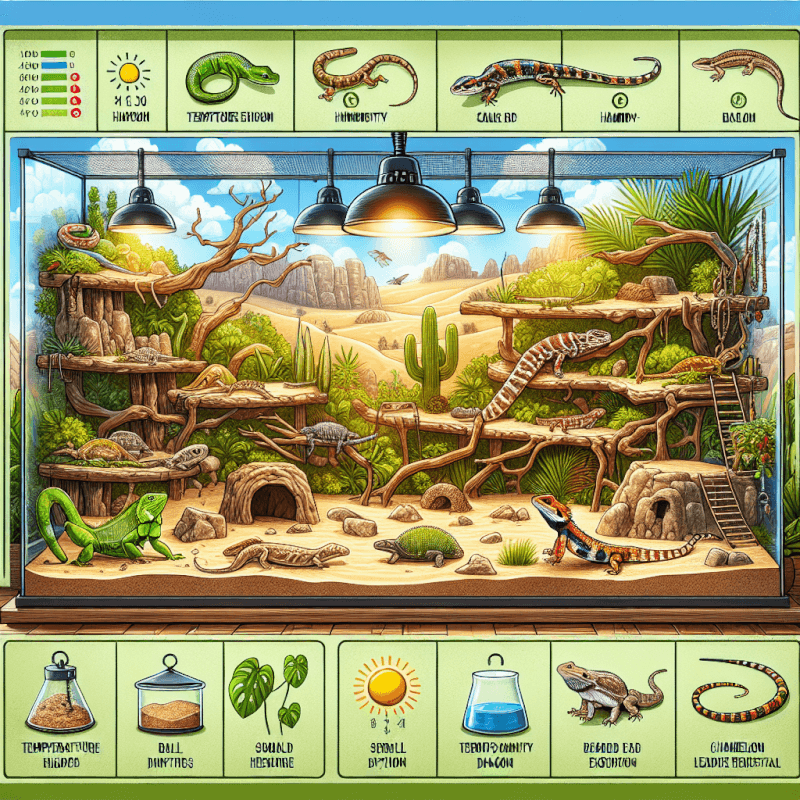Are you a lover of reptiles? If so, you may have wondered if it’s possible to keep different species of reptiles together in the same enclosure. It’s a common question among reptile enthusiasts, and in this article, we’ll explore the factors to consider when considering housing different reptile species together. From understanding their habitat requirements to ensuring compatibility, we’ll provide you with the insights you need to create a harmonious reptile community in your own home. So, if you’re curious about creating a reptile paradise, keep reading!

Understanding Reptile Behavior
Reptiles are fascinating creatures with a unique set of behaviors that vary among species. It is important to understand these behaviors in order to successfully keep different species of reptiles together. Here are some key aspects of reptile behavior to consider.
Territorial Behavior
Many reptiles exhibit territorial behavior, meaning they establish and defend their own space. This behavior can range from marking their territory with scent glands to engaging in physical aggression with intruders. It is crucial to understand the territorial nature of reptiles and provide adequate space and resources for each individual in a shared enclosure.
Aggression
Reptiles, especially males, can display aggressive behavior towards other individuals. This aggression is often triggered by competition for mates, territory, or resources. It is essential to monitor the behavior of reptiles closely when they are housed together to prevent any potential harm or stress to the animals.
Compatibility
Compatibility between different species of reptiles is a key factor in determining whether they can be kept together. Some reptile species have natural relationships in the wild, while others may have conflicting needs or behaviors. It is important to research the compatibility of different reptile species before considering cohabitation.
Factors to Consider
When deciding to keep different species of reptiles together, several factors should be taken into consideration to ensure the well-being of all individuals involved.
Size and Habitats
The size of the reptiles and their habitats is an important factor in determining compatibility. Larger reptiles may pose a threat to smaller ones, which can result in injury or even death. It is crucial to provide adequate space for each reptile species to minimize the risk of aggression or territorial disputes.
Diet and Feeding
Reptiles have diverse dietary needs, and it is essential to ensure that each species receives appropriate nutrition. In a shared enclosure, it can be challenging to monitor and control the feeding habits of each individual. Careful consideration should be given to the compatibility of species with similar dietary requirements to avoid competition or predation.
Temperature and Humidity
Reptiles have specific temperature and humidity requirements to maintain their health and well-being. Species with significantly different temperature or humidity needs may not be compatible for cohabitation. It is important to create suitable microclimates within a shared enclosure to accommodate the needs of each reptile species.
Social Structure
Some reptile species are solitary, while others live in social groups. Understanding the social structure of different species is crucial when considering their compatibility. Introducing solitary reptiles to social species can result in stress or aggression. It is essential to research the natural social behavior of each species and provide suitable companionship or solitude.
Examples of Compatible Reptiles
While not all reptile species can be safely housed together, there are some combinations that have been found to be compatible under the right conditions.
Leopard Geckos and African Fat-Tailed Geckos
Leopard geckos and African fat-tailed geckos are both popular pet reptiles known for their docile nature. They can often be housed together successfully, given adequate space and the appropriate setup. However, it is essential to monitor their behavior and provide multiple hiding spots to minimize territorial disputes.
Corn Snakes and King Snakes
Corn snakes and king snakes are two species of non-venomous snakes known for their relatively calm and non-aggressive behavior. They can be housed together if provided with ample space and hiding spots. However, it is crucial to consider the potential size difference between the two species, as larger king snakes may prey on smaller corn snakes.
Ball Pythons and Carpet Pythons
Both ball pythons and carpet pythons are popular pet snakes that can coexist in a shared enclosure under the right circumstances. These species have similar temperature and humidity requirements, making it easier to create suitable living conditions. It is important to monitor their feeding habits carefully and ensure that each snake receives an adequate food supply.
Red-Eared Sliders and Painted Turtles
Red-eared sliders and painted turtles are two species of freshwater turtles that can be housed together successfully. These turtles have similar environmental requirements and are often found in the same habitats in the wild. Providing a spacious aquatic enclosure with adequate basking areas and hiding spots will help prevent any potential conflicts.
Avoiding Mixing Reptiles
While there are some instances where different species of reptiles can cohabitate, it is generally recommended to avoid mixing reptiles from different groups.
Venomous and Non-Venomous Snakes
Mixing venomous and non-venomous snakes is extremely dangerous and should never be attempted. Venomous snakes can pose a significant health risk to both humans and other reptiles. It is essential to understand the potential dangers associated with venomous reptiles and exercise caution when handling or housing them.
Cold-Blooded and Warm-Blooded Reptiles
Cold-blooded reptiles, such as snakes and lizards, have specific temperature requirements to regulate their bodily functions. Warm-blooded reptiles, such as turtles and tortoises, have different temperature needs. Attempting to house these two categories together can result in stress or even death for one or both species. It is crucial to provide appropriate temperature gradients within enclosures and ensure that each species receives the necessary conditions for their physiological well-being.

Housing and Enclosures
The housing and enclosure setup for mixed species of reptiles should be carefully designed to accommodate the specific needs of each species.
Individual Cages
In some cases, it may be necessary to house different species of reptiles in separate enclosures. This is particularly important when dealing with species that have significantly different requirements or behaviors. Individual cages allow for better temperature and humidity control, as well as reducing the risk of territorial disputes or aggression.
Shared Enclosures
When keeping compatible reptile species together, a shared enclosure can be an option. However, it is crucial to ensure that the enclosure is spacious enough to provide adequate space for each individual. The enclosure should also be equipped with multiple hiding spots, basking areas, and appropriate environmental enrichment to promote the well-being of all reptiles involved.
Proper Habitat Setup
Regardless of whether reptiles are housed individually or in shared enclosures, it is essential to provide a proper habitat setup. This includes providing appropriate substrate, temperature gradients, hiding spots, basking areas, and sources of UVB lighting. Each species may have specific requirements, and research should be conducted to ensure that the habitat setup meets the needs of all reptiles involved.
Quarantine Process
Before introducing reptiles to a shared enclosure, a quarantine period should be implemented to ensure the health and well-being of all individuals.
Importance of Quarantine
Quarantine is a critical step in preventing the spread of diseases and parasites. During the quarantine period, newly acquired reptiles should be housed separately from other reptiles to observe for any signs of illness or infection. This helps protect the existing reptiles in the collection and allows for proper treatment or isolation if necessary.
Duration and Monitoring
The duration of the quarantine period may vary depending on the species and individual circumstances. However, a minimum quarantine period of several weeks is generally recommended. During this time, the reptiles should be closely monitored for any signs of illness, such as changes in appetite, behavior, or physical appearance. Regular veterinary check-ups and fecal examinations can also be performed to ensure the health of the quarantined reptiles.

Introduction Techniques
Introducing reptiles to a shared enclosure requires careful planning and gradual introduction techniques to minimize stress and potential conflicts.
Visual Separation
One technique is to initially keep the reptiles visually separated while allowing them to become accustomed to each other’s presence. This can be achieved by using dividers or clear barriers within the enclosure. This allows the reptiles to see and smell each other without direct contact, reducing the potential for aggression.
Scent Exchange
Scent exchange can be another helpful technique in introducing reptiles to each other. This involves swapping the bedding or substrates between enclosures to allow the reptiles to become familiar with each other’s scent. This can help facilitate the recognition and acceptance of new individuals within the enclosure.
Controlled Interaction
Gradual and controlled interaction between reptiles can be introduced once visual separation and scent exchange have been successful. This can involve supervised physical interaction, such as supervised cohabitation or supervised time spent in a larger, neutral territory. Close monitoring is crucial during this process to ensure the safety and well-being of all reptiles involved.
Monitoring and Supervision
Ongoing monitoring and supervision are essential when different species of reptiles are housed together.
Behavior Observations
Regular observation of reptile behavior is crucial to identify any signs of stress, aggression, or illness. Any changes in behavior, such as increased aggression, reduced appetite, or unusual hiding patterns, should be noted and addressed promptly. Close attention should also be paid to social interactions between reptiles to ensure that conflicts or dominance behaviors do not escalate.
Feeding and Health Checks
Monitoring the feeding habits and overall health of each reptile is important in a mixed species enclosure. Ensuring that each reptile receives adequate nutrition and is free from any signs of illness or infection is crucial. Regular health checks, including veterinary examinations and fecal testing, can help identify and address any health issues before they become significant problems.

Professional Advice
Seeking professional advice is always recommended when considering keeping different species of reptiles together.
Consulting a Reptile Veterinarian
A reptile veterinarian can provide valuable guidance and expertise in assessing the compatibility and health of different species of reptiles. They can offer advice on appropriate housing, feeding, and monitoring techniques. Regular veterinary visits can also help ensure the overall health and well-being of the reptiles in a mixed species enclosure.
Seeking Guidance from Reptile Experts
Reptile experts, such as experienced reptile breeders or keepers, can provide practical insights and tips based on their own experiences. They can share their knowledge on successful cohabitation arrangements and help troubleshoot any issues that may arise. Seeking guidance from experienced reptile experts can greatly increase the chances of a successful mixed species enclosure.
Potential Risks and Precautions
While mixing different species of reptiles can be done successfully, it is crucial to be aware of the potential risks and take appropriate precautions.
Disease Transmission
Reptiles can carry diseases and parasites that can be easily transmitted between individuals. It is important to ensure that all reptiles introduced into a shared enclosure are healthy and free from any infectious diseases. Regular veterinary check-ups and appropriate quarantine procedures can help minimize the risk of disease transmission.
Injury and Predatory Behavior
Some reptile species have natural predatory instincts and may pose a threat to smaller or more vulnerable species. It is crucial to carefully consider the size, behavior, and predatory tendencies of each species before introducing them to a shared enclosure. Providing ample hiding spots and monitoring interactions closely can help prevent injuries or predation.
Stress and Neglect
Keeping different species of reptiles together can potentially result in stress or neglect for some individuals. It is important to monitor the behavior and overall well-being of all reptiles involved and provide immediate intervention if any signs of stress or neglect are observed. Providing adequate resources, space, and environmental enrichment can help minimize stress and promote the overall welfare of the reptiles.



